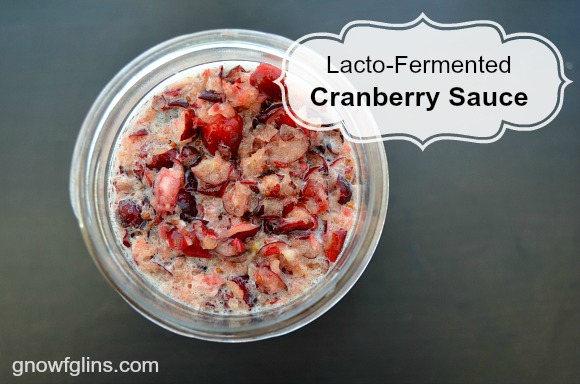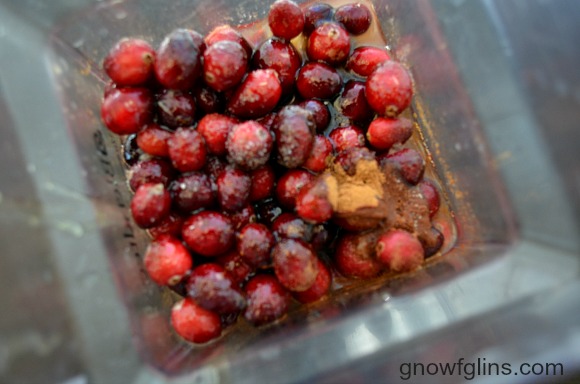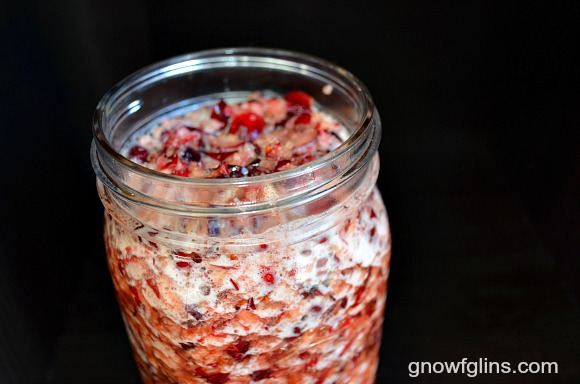
Cranberry sauce is a delightful staple at a traditional holiday feast. And fermenting it only improves it.
The process of lacto-fermentation can be used to enhance the health benefits of many fruits, vegetables, and beverages. It is called lacto-fermentation because of the presence of lactobacilli (a beneficial bacteria).
Sally Fallon writes in her book, Nourishing Traditions (page 89):
“The proliferation of lactobacilli in fermented vegetables enhances their digestibility and increases vitamin levels. These beneficial organisms produce numerous helpful enzymes as well as antibiotic and anticarcinogenic substances. Their main by-product, lactic acid, not only keeps vegetables and fruits in a state of perfect preservation but also promotes the growth of healthy flora throughout the intestine.”
Learn more about lacto-fermentation here.
By utilizing this fermentation process we can turn cranberry sauce into an easily digested, probiotic condiment.
Sound good?
This recipe for fermented cranberry sauce is very simple to make. The only extra consideration would be ensuring you have whey on hand.
Whey can be obtained by straining plain yogurt or kefir with active cultures, but it does take several hours, so plan ahead. You can find the instructions for doing this in Wardee’s post: Whey — What it is and How to Get it (there’s even a video demonstration).
Or, if you’re dairy-free or prefer not to use whey, you could use a starter culture such as Caldwell’s, available at Wise Choice Market (click on Starter Cultures in the left-hand side bar when you get there). Just activate one package in a 1/4 to 1/2 cup of warm water with a pinch of sugar.
If the “lacto fermenting” is too daring for your family at this time, try mixing a little whey with regular cranberry sauce just before serving. This will make it probiotic!
Lacto-Fermented Cranberry Sauce
- 12 ounces fresh cranberries
- 1/2 cup honey
- 1 tsp sea salt
- 1/3 cup of whey
- 1/2 cup apple juice (or grape juice)
- 1 tsp cinnamon
- Juice from 1 orange
- 1 teaspoon of orange zest
- Optional: 1/2 cup pecans (if you use these, you will end up with a little more than a quart)
Yields one quart.
Place all ingredients (except orange zest) in a blender or food processor.

Pulse a few times until the desired consistency is reached. I prefer mine slightly chunky.
Add orange zest and stir to distribute evenly.
Pour into a quart-sized canning jar, leaving one inch of head space. Close tightly with lid or airlock and leave at room temperature to ferment for 48 hours. (Be sure to close lid tightly as the presence of oxygen may ruin the fermentation.)

Once fermented, refrigerate. Eat within 2 months.
Note: Use caution when opening the jar, as gases can build up inside. Open the lid a little at a time to let some of the gas escape before removing the lid.
Now you have a cranberry sauce loaded with beneficial enzymes and probiotics. Serve alongside the meat of your choosing — or it’s delicious as a yogurt topping!
Have you fermented cranberries or other condiments before? What are your favorite fermented condiments?
Want more cranberry recipes? Check out Wardee’s cranberry-orange-apple relish, Fresh Cranberry Orange Relish, or these 6 stunning and nourishing cranberry sauces.
Want more on fermentation? Check out the Lacto-Fermentation online class or eBook or Wardee’s book The Complete Idiot’s Guide to Fermenting Foods.
We only recommend products and services we wholeheartedly endorse. This post may contain special links through which we earn a small commission if you make a purchase (though your price is the same).


Thank you so much, Stacy, for sharing! Your recipe looks delicious and nutritious. Expanding the line of lacto-fermented food into my family’s diet continues to be a goal of mine, and I look forward to using your recipe to to increase the amounts of probiotic food around the house.
Hi,
I am an organic vegetarian and am no longer consuming dairy. Can I ferment with organic soy yogurt the same way I used to with whey?
I have recently learned about Ultrametabolism and wish to follow this program. I also wish to continue to ferment my foods.
Thank you,
bonnie
The whey is more of an activator to speed the process. Other things can be used, such as raw vinegar, lemon juice (which is in this recipe) can also be used, but will probably change the flavor a little. The thing with lacto-fermentation is that in nature, all living things are covered in bacteria. This is a great thing, because without it we cannot survive. By adding the salt and the lemon juice, it makes the concoction more habitable for the good bacteria and less habitable for the bad bacteria. Thus, by giving the good a leg up, and inhibiting the bad, it preserves the food. Because of this, the recipe could probably use absolutely no whey if desired, but will probably take longer. Tasting would be necessary after 3 days, then again and so on until it is the desired taste is reached.
Thanks for the recipe! Made this last week and have been mixing it in my morning yogurt for the last couple days. Time to make another batch. Think I’ll do a half gallon instead of a quart.
Could I just use whey from making mozzarella cheese since it isn’t heated passed the 90 degrees? I made mine and it still has a sweetness to it…I checked at 2 days and let it go 3 1/2 days since it is the winter and we keep our house cooler.
My mozzarella whey is heated past 90 degrees F — in fact, it goes quite high so it can’t be used. If yours isn’t, that would be fine.
This recipe is delicious! I made it the minute I saw it. Thank you for such a wonderful new fermented food. Now I will have a beautiful red condiment besides the fermented black beans and white sauerkraut. Also wanted to let you know that one can use powdered probiotics (such as PB8) instead of the whey when making fermented foods. I prefer the probiotics as it is easy to store those in the cupboard for several months.
I love the idea of using it as a yogurt topping. We have been making yogurt but running short on ways to sweeten it up a bit. Definitely going to try this one!
Thank you for sharing this recipe! I will be trying this in the next few days, but instead of using a starter culture, I’m going to try a wild fermentation using the natural lacto-bacilli and yeast microbes found on the organic cranberries my wife just brought home. I’ll also be throwing some organic ginger in, as I’ve had good luck creating a “ginger bug” starter with it, and it should complement the flavors nicely.
Could you use water kefir instead of whey here? We don’t do dairy and I really want to be able to make this in a sustainable way (not purchase one use starters every time I want to make something).
I love this recipe. I had a large qty of black currants recently, and searched all over the web for any fermenting recipes. I didn’t find any, so I used this recipe but seasoned with red onion and coriander seed, just to try it. I am happy to report that black currants are extremeley fermentable, so much so that I have had to reduce the qty in my jars twice, and have decided to store the jars in my fridge instead of cool cellar where I usually put ferments. Its a little early to report on the flavor, I am planning to use it during winter as a major immune tonic, next to meats. I think the intense flavor of black currants will be very appealing then, and their amazing qualities will be well appreciated by our bodies. One jar was so explosive I decided to load it with rapadura and use it as a jam right away. But I am anyway feeling that a small quantity of black currants could be a very helpful recipe addition when fermenting something a bit more challenging, like beets, because they seem so very joyous at it, they love to ferment!
I also wonder if you could substitute1/3 cup water kefir for the whey in this recipe. Thoughts?
Have a few questions about fermentation. First of all, I’m allergic to acidophilus so I can’t eat yogurt or use supplements with acidophilus in it, or use probiotic. In addition, I can’t eat fresh yeasts like when making homemade breads, etc. So is whey something I can use? It has been tough on me the last year since I had two back surgeries one due to an abscess and removal of bone. Sent home on IV therapy for over a month. My good bacteria is gone from all of that so not sure what to do to get in back. I would love to be able to make the recipe above and other fermentation recipes. Any recommendations would greatly be appreciated. Thank you so much.
Can I make this without added sugar or honey? Would it simply be sourer?? I am off sugar. I know that ferments eat most of it, but was still wondering about skipping it. I can add Sukrin for a slightly sweeter taste. That is made from stevia
Thank you for posting this recipe!!